Why Does a High-Voltage Bulb Glow Brightly When Connected in a Parallel Circuit, While a Low-Voltage Bulb Glows Dimly in the Same Circuit?
Three light bulbs are connected in a parallel circuit across the source voltage of 230V AC supply.
- The rating of the first bulb is 5 Watts
- The rating of the middle bulb is 25 Watts.
- The rating of the last bulb is 5 watts.
Now, why does the middle bulb (high wattage 25 watts) connected in the parallel circuit glow brighter than the first and last bulbs (each rated at 5 watts) connected in the same circuit and glowing dimmer?
Related Posts:
- Why Does the High-Wattage Bulb Glow Dimmer in a Series Circuit?
- Which Bulb Glows Brighter When Connected in Series and Parallel and Why?
The primary reason for this scenario is the fundamental principle that a bulb dissipating more power will glow brighter, regardless of whether it is connected in a series or parallel circuit. In other words, a bulb with higher resistance will glow brighter, while a bulb with lower resistance will glow dimmer. This is because the bulb with lower resistance dissipates less power. The brightness of a bulb is directly proportional to the power it dissipates, as more power results in more light output.
Now, we will calculate the current flowing through each bulb and determine the resistance of each one because the brightness of a light bulb depends on the current, voltage, and its resistance. These values are important because the brightness of the bulb is determined by the power it dissipates, not simply by its rated power.
Since this is a parallel circuit, the voltage across each branch remains the same, while the total current is the sum of the currents through each branch. Additionally, the total resistance of multiple resistors in parallel is always less than the smallest individual resistance in the circuit.
- Current in parallel circuit: IT + I1 + I2 + I3 … + In
- Voltage in parallel circuit: VT = V1 = V2 = V3 … = Vn
- Resistance in parallel circuit: RT = 1/R1 + 1/R2 + 1/R3 …+ 1/Rn
- Related Post: Why is Earth Pin Thicker and Longer in a 3-Pin Plug?
Finding Total Resistances of the Bulbs
As there will be the same voltage level, i.e., 230V, across each bulb in the parallel circuit, we can use Ohm’s Law to determine the resistance of each bulb, which will allow us to calculate the power dissipation by the light bulb (P = V×I). Let’s find the resistance of each bulb using Ohm’s law.
Resistance of 5W Bulb (Each)
- ➺ R5W = V2 / P5W
- ➺ R5W = 2302 / 5W
- ➺ R5W = 10,580 Ω
This is the resistance value for both the first and last bulbs, which are rated at 5W. Let’s find the resistance of the bulb connected in the middle, which has a high wattage rating, e.g., 25W.
Resistance of 25W Bulb (Connected in the Middle)
- ➺ R25W = V2 / P25
- ➺ R25W = 2302 / 25W
- ➺ R25W = 2,116 Ω
We see that the resistance of the high-wattage (25W) rated bulb connected in the middle of the parallel circuit is lower than the resistance of the low-wattage bulbs (5W).
Finding Power Dissipation of the Bulbs
As we know that the same voltage (e.g. 230V) is available across each light bulb, hence, the power dissipated by the lower wattage bulb (either the first one or the last one, each having a 5-watt rating) can be calculated using the power dissipation formula (P = V2 ÷ R).
Power Dissipated by 5W Bulbs (Each)
- ➺ P5W = V2 ÷ R5W
- ➺ P5W = (230V)2 x 10,580Ω
- ➺ P5W = 5 Watts.
Power Dissipated by 25W Bulb
Similarly, the power dissipated by the 25W bulb connected in the middle of the parallel circuit
- ➺ P25W = V2 ÷ R25W
- ➺ P25W = (230V)2 x 2,116Ω
- ➺ P25W = 25 Watts.
Now, we observe that the 25-watt bulb, which is connected in the middle of the parallel circuit, is consuming more power (25 watts) compared to the first and last bulbs, each of which consumes 5 watts. This is why the middle bulb, having a higher wattage rating, glows brighter than the other two lower-wattage bulbs, which glow dimmer.
Alternatively, you can calculate the total resistance of the bulbs using the formula for equivalent resistance in a parallel circuit. In this case, the equivalent resistance is 1,511.43 ohms. After finding the total resistance, you can calculate the voltage drop across each bulb by multiplying the current flowing through each bulb by its corresponding resistance. Use a calculator to perform these calculations accurately.
- Total Resistance = RT = 1,511.43 Ohms
- Current flowing in 5-W bulb (each) = 21.74 mA
- Current flowing in 50-W bulb = 108.8 mA
- Total Current = IT = I1 + I2 + I3 = 152.2 mA
- Total Voltage Drops = VDrop = 230V
Related Posts:
- What is the Objection to having Light Bulbs & Lamps Connected in Series?
- Advantages of Parallel Lighting Circuit over a Series Circuit
Good to Know: The scenario is completely different and opposite when all the above bulbs, having the same ratings, are connected in a series circuit. In a series arrangement, the high-wattage bulb will glow dimmer, while the low-wattage bulbs will glow brighter..
Based on the above calculations, we now understand why the low-wattage bulbs (5W) glow dimmer, while the high-wattage bulb glows brighter in a parallel circuit. This happens because the same voltage is applied across each bulb, but the wattage ratings and resistance values differ.
The high-wattage bulb has a lower resistance, allowing more current to flow through it, which results in higher power dissipation and brighter illumination. In contrast, the low-wattage bulbs have higher resistance, so less current flows through them, resulting in lower power dissipation and dimmer light.
Good to Know: The objection to connecting lighting points in series is that a parallel connection is preferred for connecting lighting fixtures, as it offers several advantages over a series circuit.
Related Posts:
- Will I Get an Electric Shock If I Touch the Ground Wire?
- Can the Neutral Wire Cause Electric Shock? Different Cases
- Will a Man Get an Electric Shock If He Hangs on a Live Wire?
- What are the Colored Aerial Marker Balls on Power Lines For?
- Why is the Grounding Wire Bare and Not Insulated?
- What are the Tiny Cylinders in Power Cords and Cables?
- Introduction to Series, Parallel and Series-Parallel Connections
- Series, Parallel and Series-Parallel Connection of Batteries
- Difference Between Series and Parallel Circuit – Comparison
- How To Wire Switches In Series?
- How To Wire Switches in Parallel?
- How To wire Lamps in Series?
- How To Wire Lamps in Parallel?


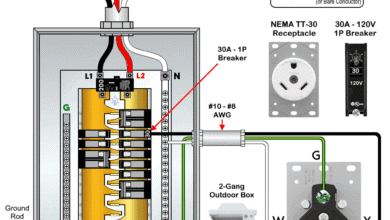 How to Wire NEMA TT-30 Receptacle for RVs & Travel Trailers
How to Wire NEMA TT-30 Receptacle for RVs & Travel Trailers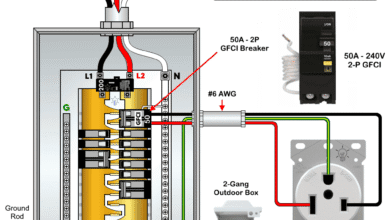 How to Wire a 50A – 250V, NEMA 6-50 Receptacle
How to Wire a 50A – 250V, NEMA 6-50 Receptacle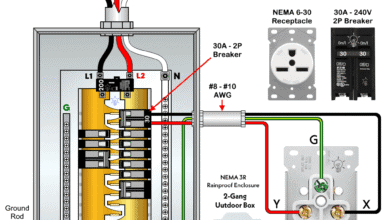 How to Wire a 30A – 250V, NEMA 6-30 Receptacle
How to Wire a 30A – 250V, NEMA 6-30 Receptacle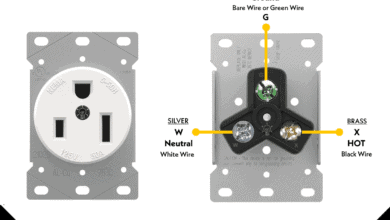 How to Wire a 50A – 125V – NEMA 5-50 Receptacle
How to Wire a 50A – 125V – NEMA 5-50 Receptacle How to Wire 600/347V, 1-Phase & 3-Phase Main Service Panel
How to Wire 600/347V, 1-Phase & 3-Phase Main Service Panel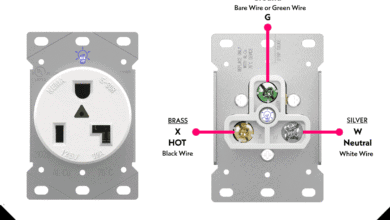 How to Wire a 30A – 125V – NEMA 5-30 Receptacle
How to Wire a 30A – 125V – NEMA 5-30 Receptacle